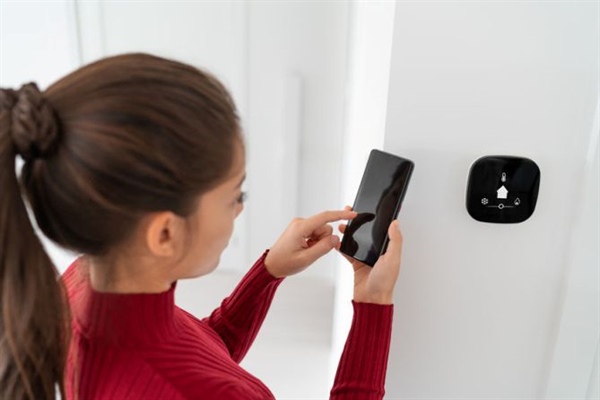What Is a Smart Thermostat?

We now live in an age where you can control the temperature of your home from your smartphone. This convenient option offers you time and money-saving opportunities, among other benefits.
This magical device is called a smart thermostat. It operates the same way that a traditional thermostat does, except it has added features like programmable temperature control, smart learning, automatic diagnostic checks, and routine maintenance scheduling.
Let’s take a closer look at some common smart thermostat features...
Programmable Temperature Control
A smart thermostat allows you to adjust the temperature of your unit remotely via your phone, tablet, or other smart device. You can even schedule desired temperature settings for optimal home comfort and efficient energy consumption. Instead of a heating and cooling system that runs constantly, a smart thermostat cools and heats your home as needed.
Smart Learning Features
Some smart thermostats are capable of detecting patterns in your indoor temperature preferences. They can then automatically adjust based on what you have previously set your cooling and heating settings at.
Automatic Diagnostics Check
Smart thermostats can also run automatic system diagnostic tests to see how well your unit is performing and if you need to schedule a repair or maintenance. They can also notify you of any red flags they found during the system check or things that need to be looked at with your unit.
Since smart thermostats can spot internal issues, they decrease the likelihood of your HVAC system breaking down.
Routine Maintenance Reminders
It can be hard knowing when you need to get your A/C unit serviced. Your smart thermostat can remind you when it’s time to schedule a routine maintenance checkup or change out your air filter. Plus, a smart thermostat can give you a full report on your unit’s energy consumption levels.
How a Smart Thermostat Works
It’s nice to know the features, but perhaps you are curious about how smart thermostats work.
Well, the principle is the same for both a smart and regular thermostat. It serves as a way to gauge the room's temperature and either turn on the A/C or the heat, depending on the temperature settings you put into it.
The biggest difference is that smart thermostats hook up to Wi-Fi. Using a companion app, you can put in your ideal temperature settings from your smart or mobile device. Your smart thermostat will then send a signal to your HVAC unit to set your house to the desired temperature you put in.
And that’s it! You can then manage your home temperature settings from the convenience of your own phone.
Do Smart Thermostats Make Your Home More Energy Efficient?
The short answer is yes: smart thermostats can make your home more energy efficient. They are just one of many ways to improve your home’s energy efficiency.
Smart thermostats allow you to adjust your temperatures so you can optimize your furnace and air conditioner’s performance, only running when they need to. Smart thermostats can adjust the temperature based on your schedule.
Smart thermostats work great for businesses, too! If you have a business, control your interior temperature with a smart thermostat to accommodate your employees’ work schedules. Or, if the office tends to get warm at certain times of the day, you can program your thermostat to lower the temperature to compensate for the extra warmth from the sun.
How to Choose a Smart Thermostat
Choosing a smart thermostat requires a little investigation. First, you need to ensure your HVAC system can handle a smart thermostat, as they work better on newer models. You also need to consider your home’s writing.
A smart thermostat needs a c-wire to connect to your home or business’s system. If you already have one, great. If not, you may want to consider hiring a professional to install one.
Some of the more popular smart thermostats on the market include:
● Google Nest
● Ecobee SmartThermostat
● Honeywell Home
● Amazon Smart Thermostat
Each has similar features and designs, but you may want to research each one to determine which one will suit your needs.
What is the Most Optimal Temperature for Your Home?
The optimal temperature in the winter is 68 degrees Fahrenheit. This will keep your home warm while maintaining the temperature low enough not to keep your furnace running all day and night.
There’s also a 5-degree rule. It means that when you leave the home or go to sleep, lower the thermostat by 5 degrees. It also means that in the winter, if you set your thermostat 5 degrees lower than what you would like it to be, you can save about 1% on annual heating costs.
Troubleshooting Your Smart Thermostat
Sometimes, your smart thermostat might run into a problem or two. It is easy to troubleshoot a smart thermostat, as most problems can be solved by restarting the device.
However, if that does not solve the problem, you might have a different problem. For example, if you hear weird noises coming from your furnace, that could indicate a bigger problem than your thermostat.
If you ever question whether your furnace or thermostat is working properly, call the experts to perform an inspection. That’s the quickest way to ensure your HVAC system is working properly.
Get a Smart Thermostat Installed by Our HVAC Experts
Quality Systems Heating & Cooling has you covered for all your air conditioning maintenance and repair needs! We work hard to provide the best HVAC services for you by going above and beyond to ensure the best results.
Call us today at 952-226-2665 or get your free quote online to schedule your HVAC maintenance and repair.